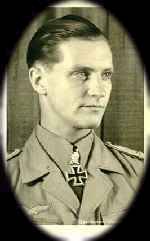
Hans-Joachim Marseille

 Hans-Joachim
Marseille, a Berliner of French descent, arrived in North Africa (I/JG 27) at the age of
21 after having served his combat apprenticeship during the later stages of the Battle of
Britain in which he was shot down four times and had seven kills to his credit. He was
transfered out of 4/JG 52 by Johannes Steinhoff for insubordination. Marseille, considered
by his new Kommandeur, Edu Neumann, to be a natural pilot, was also a superb
deflection, or off-angle marksman. He was so good, in fact, that he was able to get off
accurate deflection shots while his Bf-109 was in a roll or while
his target executed violent evasive maneuvers. His touch with the stick was sure - he wore
tennis shoes while flying for extra sensitivity on the rudder pedals - and he never
skidded in turns. His wingman, Sergeant Rainer Poettgen, said, "His judgement of
deflection was incredible. each time he fired I saw his shells strike first the enemy's
nose, then travel along to the cockpit. He wasted no ammunition."
Hans-Joachim
Marseille, a Berliner of French descent, arrived in North Africa (I/JG 27) at the age of
21 after having served his combat apprenticeship during the later stages of the Battle of
Britain in which he was shot down four times and had seven kills to his credit. He was
transfered out of 4/JG 52 by Johannes Steinhoff for insubordination. Marseille, considered
by his new Kommandeur, Edu Neumann, to be a natural pilot, was also a superb
deflection, or off-angle marksman. He was so good, in fact, that he was able to get off
accurate deflection shots while his Bf-109 was in a roll or while
his target executed violent evasive maneuvers. His touch with the stick was sure - he wore
tennis shoes while flying for extra sensitivity on the rudder pedals - and he never
skidded in turns. His wingman, Sergeant Rainer Poettgen, said, "His judgement of
deflection was incredible. each time he fired I saw his shells strike first the enemy's
nose, then travel along to the cockpit. He wasted no ammunition."
After a rough start in which he was shot down by a Free French pilot flying a Hurricane, he soon became the scourge of the RAF in North Africa. On September 24, 1941 he shot down five British planes. By February, 1942 he had shot down 48. In June in an air battle over Bir Hacheim, he destroyed six Curtis P-40 Tomahawks flown by South Africans. In a one week period after the fall of Bir Hacheim to the Germans, Marseille shot down another 20 RAF planes, bringing his score to 101. Upon returning from his 101st victory he exhibited signs of battle fatigue and was sent back to Germany for a rest and was awarded the Knight's Cross with Swords.
Marseille has been characterized as the prototype of the
twentieth-century knight. A dashing and chivalrous individual
with a zest for life. His two month leave after his 101st victory was seen as a long round
of parties and women and when he returned to North Africa his fan mail was enormous.
Dozens of letters were addressed to simply the 'Star of Africa'..
individual
with a zest for life. His two month leave after his 101st victory was seen as a long round
of parties and women and when he returned to North Africa his fan mail was enormous.
Dozens of letters were addressed to simply the 'Star of Africa'..
Even in the desert he needed to keep up his appearance. His quarters at JG-27's airfield consisted of several tents linked together to form adjoining rooms with carpets and furniture and he entertained senior German and Italian officers in his bar. The whole was cared for by his servent, a South African negro named Matthais.
Upon his return to North Africa, on September 1, 1942 he shot down a pair of P-40s and a pair of Spitfires within 11 minutes. He refueled and rearmed and between 10:55 and 11:05 a.m. scratched eight more P-40s. In the afternoon of the same day, between 5:47 and 5:53 p.m., he downed another five P-40s south of Imayid for an unbelievable total of 17 for the day. By September 15th he had run his score to 150. Two days later he was awarded the Diamonds to go with his Knights Cross. He was now the Luftwaffe's most decorated pilot with the Knight's Cross with Oak Leaves, Swords and Diamonds as well as the Italian Gold Medal for Bravery, which only three men were awarded during world war II. He was also awarded the status of Experte.
On September 26th his flight tangled with Spitfires and Marseille became involved in the longest dogfight of his career lasting more than 15 minutes. In the end Marseille was the victor and brought his score to 158. This was his last victory for on September 30 at 11:45 a.m., after returning from a Stuka escort mission, his cockpit suddenly filled with smoke at 4,500 ft. After radioing that he couldn't see, other members of his flight attempted to steer him in but he was forced to bail out. After opening the canopy and turning the 109 on its back he exited the cockpit. The slip stream blew him backward into the tail and he fell to the desert floor, his parachute unopened. He was burried the next day on the spot where he landed. In all the sorties he had flown over North Africa, except for the instance in which he was shot down by the Hurricane, his plane had not been hit by a single bullet. His final total of 158 included 151 in the desert- 101 P-40s, 30 Hurricanes, 16 Spitfires and 4 twin-engined bombers.